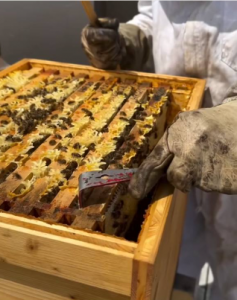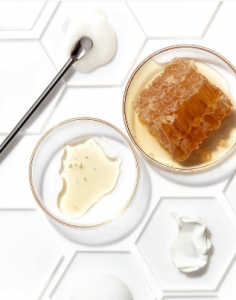
Honey and bees
Vol 26, Issue 22, 05 April 2024
Bees make honey from nectar. Nectar is a sugar—rich juice that is secreted by flowering plants. It is formed in nectarines that have evolved in the course of evolution of parts of flowers. Nectar, a high-calorie food, attracts insects, and they, in turn, pollinate plants, transferring pollen with genetic material from one to another, thereby allowing plants to reproduce. The bee sucks nectar into its body with the help of a proboscis formed from a strongly shifted lower lip and a pair of lower jaws. But there is also the so-called honeydew: bees produce it from animal honeydew, the sweet secretions of insects living on plant leaves, or from honeydew, the juice that protrudes on leaves (or conifers) due to a sharp temperature drop.

Bees have an interesting digestive system. Its most important organ is the honey goiter, the storage and place of primary processing of nectar, which the bee collects with its proboscis. The goiter is separated from the middle intestine by a special valve, so that nectar enters it only when the bee gets hungry, and in limited quantities. Thus, the insect carries the main part of its prey to the honeycomb, where it regurgitates it into cells. Honey is obtained due to the fact that the bee’s body secretes several enzymes that help break down nectar carbohydrates. There are no enzymes in the honey goiter, they are contained in saliva, along with which the nectar enters the goiter and begins to split. The main enzymes involved in this process are invertase, glucose oxidase and diastase.
Invertase is an enzyme that catalyzes the breakdown of sucrose into simpler sugars — fructose and glucose.
1. Glucose oxidase promotes the breakdown of glucose into gluconic acid (of all organic acids, it has the greatest effect on the taste of honey) and hydrogen peroxide. Hydrogen peroxide is unstable and breaks down afterwards, but at the beginning of the process protects honey from microorganisms.
2. Diastase (amylase) breaks down a complex carbohydrate like starch into simpler ones like maltose. This enzyme is associated with such an indicator of the quality of honey as the diastase number, that is, the amount of enzyme per unit volume. The diastase number is different for different types of honey and for honey from different regions. In lime, acacia, sunflower honey, it is low, in buckwheat honey it is high. Honey from hot climates has a lower diastase number than the same honey from colder places. But since the diastase number for a certain variety from a certain area varies within known (and even standardized by GOST) limits, lower indicators compared to the norm indicate that honey is stale, has been heated or even falsified.

Collecting bees bring the collected nectar to the hive. There he is received by the receiving bees. The receiving bee takes in the nectar brought and holds it for some time in a honey crop, where it is fermented. Then she squeezes a drop of the substance onto the tip of the proboscis to evaporate moisture, and then sucks it back for further fermentation. This procedure is repeated 120-240 times, after which the dehydrated nectar is placed in the cell. Bees transfer nectar, which turns into honey, from one cell to another more than once, and often ventilate the honeycomb with the help of wings, contributing to greater evaporation of moisture. Thus, with the help of fermentation and simultaneous reduction of the water content, the nectar turns into honey. To form 100 g of honey, you need nectar collected from about a million flowers.
- New Year’s mood - 22nd November 2024
- Minimalism is a way of life. Where to begin? - 15th November 2024
- Why do you need an air humidifier? - 8th November 2024
